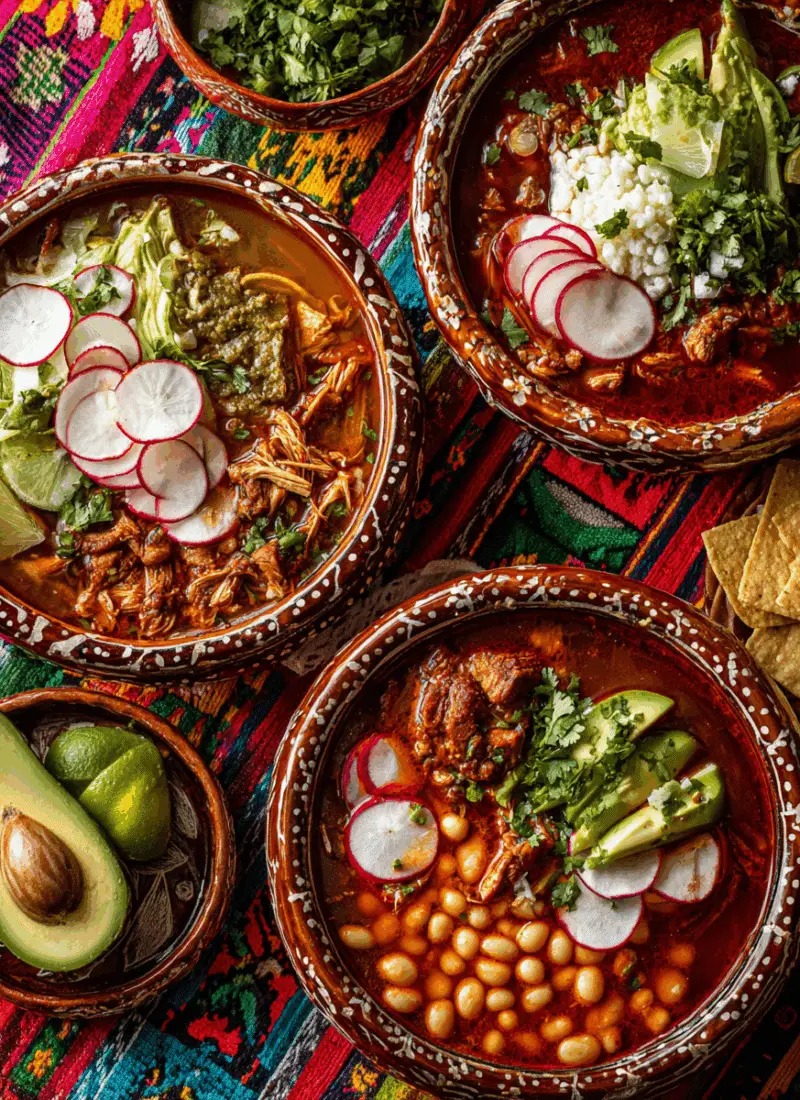Pozole is a beloved traditional Mexican soup often enjoyed during celebrations such as Mexican Independence Day. It features tender pork or chicken, hominy (nixtamalized corn), and a flavorful broth. Depending on the region and personal taste, pozole can be made as rojo (red) with dried chiles or verde (green) with tomatillos and green herbs. Both variations are rich, comforting, and garnished with fresh toppings that add crunch, acidity, and spice making pozole a festive, customizable, and deeply satisfying dish.
FULL RECIPE
Ingredients
1.For Pozole Rojo:
- 2 lbs pork shoulder (cut into chunks)
- 1 onion (halved)
- 5 garlic cloves (peeled)
- 1 bay leaf
- Salt, to taste
- 8 cups water
- 2 (15 oz) cans of white hominy, drained and rinsed
- 4 dried guajillo chiles (stemmed and seeded)
- 2 dried ancho chiles (stemmed and seeded)
- 1 tsp cumin seeds
- 1 tsp dried oregano
- 1/2 tsp ground cloves (optional)
2.For Pozole Verde:
- 2 lbs chicken thighs (bone-in or boneless)
- 1 onion (halved)
- 5 garlic cloves
- Salt, to taste
- 8 cups water
- 2 (15 oz) cans of white hominy, drained and rinsed
- 1 lb tomatillos (husked and rinsed)
- 2 poblano peppers (roasted and peeled)
- 1/2 cup fresh cilantro
- 1/2 cup fresh parsley
- 2 jalapeños or serrano peppers (optional for heat)
- 1 tsp cumin seeds
- 1 tsp dried oregano
3.Optional Garnishes (for both types):
- Shredded cabbage or lettuce
- Sliced radishes
- Diced onion
- Lime wedges
- Avocado slices
- Dried oregano
- Crushed red pepper flakes
- Tortilla chips or tostadas
Directions
Pozole Rojo:
- In a large pot, combine pork, onion, garlic, bay leaf, salt, and water. Bring to a boil, then reduce to a simmer. Skim off any foam and simmer for 1.5–2 hours until pork is tender.
- While the pork cooks, soak dried chiles in hot water for 15 minutes until softened. Drain.
- In a blender, combine softened chiles, cumin, oregano, cloves (if using), and 1/2 cup broth. Blend until smooth.
- Strain the chile sauce into the soup pot with the pork. Add hominy.
- Simmer for another 30 minutes to let flavors meld. Adjust seasoning with salt as needed.
- Serve hot with your choice of garnishes.
Pozole Verde:
- In a large pot, combine chicken, onion, garlic, salt, and water. Bring to a boil, then simmer for 45 minutes to an hour until the chicken is cooked through.
- Remove chicken, shred, and set aside. Reserve broth.
- In a saucepan, boil tomatillos until soft (about 10 minutes). In a blender, combine tomatillos, poblano peppers, cilantro, parsley, jalapeños (if using), cumin, and oregano. Blend until smooth.
- Pour green sauce into the pot with reserved broth. Add hominy and shredded chicken.
- Simmer for 20–30 minutes. Adjust salt to taste.
- Serve hot with your choice of garnishes.
Nutrition Facts
- Calories: 380 (Rojo) / 340 (Verde)
- Protein: 28g (Rojo) / 26g (Verde)
- Fat: 18g (Rojo) / 14g (Verde)
- Saturated Fat: 6g (Rojo) / 3g (Verde)
- Carbohydrates: 28g
- Fiber: 5g
- Sugar: 4g
- Cholesterol: 80mg (Rojo) / 70mg (Verde)
- Sodium: 850mg
- Vitamin A: 15% DV (Rojo) / 25% DV (Verde)
- Vitamin C: 20% DV (Rojo) / 30% DV (Verde)
- Calcium: 6% DV
- Iron: 10% DV
Health Benefits of Pozole
Pozole, whether rojo or verde, offers a balanced mix of nutrients when prepared thoughtfully. Hominy, made from nixtamalized corn, is rich in fiber, B vitamins, and minerals such as magnesium and phosphorus. The protein source—typically pork or chicken—provides essential amino acids, while the broth retains electrolytes and nutrients from slow cooking. Pozole verde, in particular, includes tomatillos, green herbs, and peppers, all of which are high in vitamin C and antioxidants. With leaner cuts of meat and limited salt, pozole can be a heart-healthy and satisfying option.
Pozole Rojo vs. Pozole Verde
Pozole rojo and pozole verde differ not only in appearance but also in flavor profiles. Pozole rojo is known for its deep, smoky, and earthy flavor, achieved by using dried chiles like guajillo and ancho. The red broth has a rich depth that complements pork beautifully. On the other hand, pozole verde is vibrant, tangy, and fresh-tasting thanks to the use of tomatillos, green chilies, cilantro, and other herbs. It is often paired with chicken, resulting in a lighter, herbaceous broth. Both versions offer unique experiences and reflect regional preferences across Mexico.
Popular Regional Variations
Across Mexico, different regions bring their own flair to pozole. In Guerrero, pozole verde is a staple and is sometimes thickened with pumpkin seeds (pepitas) for a nutty flavor. In Jalisco, pozole rojo reigns supreme and is often made with pork head or feet for a gelatin-rich broth. Sinaloa boasts a version with both red and green sauces combined, creating a complex fusion. In Central Mexico, white pozole—without chiles—is more common and is customized with condiments at the table. These regional styles reflect the diversity and creativity of Mexican home cooking.
Toppings and Garnishes
One of the joys of eating pozole is the assortment of toppings that guests can use to personalize their bowl. Crisp shredded cabbage or lettuce adds texture, while sliced radishes provide crunch and a peppery bite. Chopped onions, dried oregano, and crushed chili flakes elevate the flavor complexity. Avocado slices or lime wedges can add creaminess or acidity, balancing the rich broth. These fresh garnishes not only enhance visual appeal but also add layers of flavor, encouraging interactive and communal dining.
Serving Suggestions
Pozole is traditionally served in deep bowls with all garnishes presented on the side so guests can build their bowl to taste. It’s best enjoyed hot, ideally with a spoon and tostadas or tortilla chips for scooping. Pozole pairs excellently with a side of Mexican crema, fresh salsa, or even a light salad. For festive occasions, it can be accompanied by aguas frescas, tamales, or sweet breads like pan dulce. The customizable nature of pozole makes it perfect for both casual family dinners and elaborate holiday feasts.
Drink Pairings
While pozole is comforting on its own, pairing it with the right beverage enhances the dining experience. Traditional drinks like horchata, tamarind agua fresca, or hibiscus tea (jamaica) provide refreshing contrasts to the warm, savory soup. For adult gatherings, pozole pairs well with Mexican lagers, micheladas, or even mezcal for smoky undertones that complement the chili-based broth. If serving pozole verde, try a crisp white wine or citrusy cocktail to echo the dish’s bright, zesty notes.
Make-Ahead and Storage Tips
Pozole is an excellent make-ahead meal because its flavors deepen as it sits. Cooked pozole can be stored in airtight containers in the refrigerator for up to 4–5 days. It also freezes well for up to 3 months, making it perfect for meal prepping or holiday planning. When reheating, do so gently on the stovetop to preserve texture. Keep garnishes fresh and stored separately to maintain their crunch and vibrancy. Always taste and adjust seasoning after reheating, as flavors may mellow over time.
Vegetarian and Vegan Adaptations
Pozole can easily be adapted for plant-based diets without sacrificing flavor. For a vegan pozole rojo, replace the meat with hearty ingredients like jackfruit, mushrooms, or textured vegetable protein (TVP) and use vegetable broth. For pozole verde, a mix of zucchini, pinto beans, or chickpeas with the traditional green sauce works beautifully. The key to success lies in roasting or seasoning the vegetables properly and maintaining the rich spice base of the broth. Garnishes such as avocado, radishes, and lime still shine in vegan versions.
Tips for Enhancing Flavor
Achieving deep, authentic pozole flavor depends on a few key techniques. Toasting dried chiles before blending intensifies their smoky aroma. Blending the sauce thoroughly and straining it removes bitterness and yields a smooth texture. Simmering the stew low and slow allows the ingredients to meld and the meat to become tender. Seasoning in stages—especially after adding the chile or tomatillo sauce—ensures depth and balance. Using homemade stock or broth instead of water can dramatically elevate the soup’s richness.
Conclusion
Pozole rojo or verde is more than just a soup it is a celebration in a bowl. With its ancient roots and regional adaptations, it reflects the soul of Mexican culinary heritage. From its robust broth to the playful garnishes and satisfying textures, pozole invites creativity, tradition, and community. Whether you’re preparing it for a holiday feast or a simple family meal, pozole delivers comfort and joy with every spoonful.








